Papers by Kerri Richardson
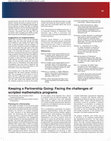
PDS Partners Bridging Research to Practice: A Journal of the National Association of Professional Development Schools, 2022
asynchronously with both the pst and mentor teacher making comments at specific points. to be mos... more asynchronously with both the pst and mentor teacher making comments at specific points. to be most impactful, this scaffolding process begins during methods courses. the type of dialogue between the mentor and pst that revolves around real-time video of a lesson allows for reflection, correction, and growth that can help psts be successful when navigating the edtpA process later during the clinical teaching placement. Suggestions for Implementation While video annotation tools can be extremely helpful, they only work when people use them fully. Goreact is user friendly, but it takes a little time to become familiar with the program. to assist with this, students are given an assignment early on that helps them get used to the video and commenting capabilities. they are asked to video a 10-15-minute mini-lesson in class and then this is shared and everyone is encouraged to make comments. these comments are based on a scaffolded set of feedback questions students are given in class prior that not only help them make relevant comments on Goreact for their peers, but also provides insight into what they need to focus on themselves. Once they receive the feedback, they must submit a reflection that addresses points that were commented on and what action, if any, they would take. Once students are in the field, this process is repeated with the mentor teacher included as well. this is typically a short lesson or one in which the pst is teaching a portion of a lesson that is not observed by the university supervisor. the pst then shares their reflection with both the university supervisor as well as the mentor. Having students go through the process a couple of times and having the mentor teacher involved, helps them feel comfortable before they record their formal lessons.
We used a teaching experiment to evaluate the preparation of preservice teachers to teach early a... more We used a teaching experiment to evaluate the preparation of preservice teachers to teach early algebra concepts in the elementary school with the goal of improving their ability to generalize and justify algebraic rules when using pattern-finding tasks. Nearly all of the elementary preservice teachers generalized explicit rules using symbolic notation but had trouble with justifications early in the experiment. The use of isomorphic tasks promoted their ability to justify their generalizations and to understand the relationship of the coefficient and yintercept to the models constructed with pattern blocks. Based on critical events in the teaching experiment, we developed a scale to map changes in preservice teachers’ understanding. Features of the tasks emerged that contributed to this understanding.

Investigations in Mathematics Learning, 2012
This"study"focuses"on"the"types"of"models"created"by"students"during"alge! braic"pattern"finding"... more This"study"focuses"on"the"types"of"models"created"by"students"during"alge! braic"pattern"finding"tasks."Attention"is"also"given"to"the"change"in"models" over"time."This"is"an"important"area"of"study"because"a"closer"look"is"needed" to" better" understand" the" models" created" during" mathematical" activity," es! pecially" in" the" elementary" classroom." It" is" reported" here" how" fifth" grade" students" used" given" concrete" models" and" created" new" representations" of" models"to"reason"algebraically"about"pattern"finding"tasks."Twenty!five"fifth" grade" students" participated" in" the" three!day" teaching" experiment." Results" indicate" that" students'" recursive" models" were" abandoned" and" then" trans! formed" to" explicit" models," and" finally" adopted" from" others" during" whole" class"discussions."These"adopted"models"in"most"cases"were"enduring"over" a"six!week"period. " Standards!based"classrooms"served"as"a"place"for"researchers"and"teach! ers"to"investigate"different"representational"forms"used"and"created"by"stu! dents" (National" Council" of"Teachers" of" Mathematics" [NCTM]," 2000)."At" the" elementary" grades" in" particular," coming" to" understand" the" processes" involved" in" a" child's" representational" thinking" and" how" the" tools" created" by" such" thinking" help" educators" gain" insight" into" students'" mathematical" generalizations" (Smith," 2008)." Lehrer" and" Schauble" (2000)" use" the" term" "modeling"" when" speaking" of" the" processes" of" representational" thinking." Such"processes"include"models"used"and/or"created"by"teachers"and"students" and"the"behaviors"associated"with"them."Models"can"take"the"form"of"hand! drawn"pictures,"symbols,"and"at"the"elementary"grades"in"particular,"infor! mal"written"or"verbal"descriptions"of"mathematical"ideas."In"differentiating" between"various"models,"the"case"is"made"that"early"reasoning"about"mod! els"is"centered"on"what"students"create"for"themselves"(Lehrer"&"Schauble,"
Abstract: We used a teaching experiment to evaluate the preparation of preservice teachers to tea... more Abstract: We used a teaching experiment to evaluate the preparation of preservice teachers to teach early algebra concepts in the elementary school with the goal of improving their ability to generalize and justify algebraic rules when using pattern-finding tasks. Nearly all of the elementary preservice teachers generalized explicit rules using symbolic notation but had trouble with justifications early in the experiment. The use of isomorphic tasks promoted their ability to justify their generalizations and to understand the relationship of the coefficient and yintercept to the models constructed with pattern blocks. Based on critical events in the teaching experiment, we developed a scale to map changes in preservice teachers' understanding. Features of the tasks emerged that contributed to this understanding.
In this three-day teaching experiment along with follow up interviews, algebraic concepts related... more In this three-day teaching experiment along with follow up interviews, algebraic concepts related to pattern-finding tasks were examined with 25 fifth grade students. The specific focus centered on representations from a realistic mathematics education perspective, meaning a model “of” a situation toward a model “for” a situation. Within this context, certain situational models were found that seemed to travel and permeate throughout the entire class. Students were able to generalize and justify based on the models developed during whole class discussions. Several weeks after the teaching experiment, follow up interviews indicated that the representations generated were still prevalent in students’ descriptions of the activities. Findings, analysis of findings, and implications of the study will be discussed.
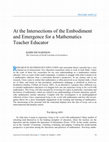
ESEARCH IN MATHEMATICS EDUCATION and curriculum theory currently has a very limited set of inters... more ESEARCH IN MATHEMATICS EDUCATION and curriculum theory currently has a very limited set of intersections. Few education researchers claim to work in both fields. I draw on the work of those few researchers for my own understandings as a mathematics teacher educator. Now as a part of this small community, I continue to struggle with what it means to be a mathematics educator from a curriculum theorist’s perspective. In my journey and in my research, I have come to realize that mathematics is often perceived as an external truth, a fixed set of ideas, and based on that perception, mathematics pedagogy is proffered as basics-as-breakdown (Jardine, Clifford, & Friesen, 2003). As an alternative, I propose that a different way to consider mathematics education is to imagine how one can experience being in the world with mathematics. This being with idea emerged by reviewing two topics in particular: curriculum and the history of mathematics, which are central to my understandings of teach...
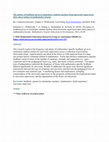
Mathematics Teacher Education and Development, 2018
This research explores the frequency and nature of mathematics-specific feedback given to element... more This research explores the frequency and nature of mathematics-specific feedback given to elementary student teachers by university supervisors across a collection of post-lesson observation forms. Approximately one-third of the forms (n=250) analysed from five large universities had no comments related to mathematics. Forms that did have mathematics-specific feedback varied in terms of the number of summary, strength, and suggestion (i.e., type) comments and in the pedagogical focus (e.g., tasks, discourse) of those comments. Chi-square tests of independence indicated the frequency of forms with mathematics-specific feedback differed significantly by university. Results of additional Chi-square tests showed significant interactions between the type of comments and university and between the pedagogical foci of the comments and comment type. Contributing factors and implications, including connectedness of the university supervisors to the programs, professional development provi...
Australian primary mathematics classroom, 2010
The key aspects and features of different connected tasks that assist teachers in helping student... more The key aspects and features of different connected tasks that assist teachers in helping students in the classroom build blocks of reasoning and proof are discussed. Various examples of different types of connected tasks are highlighted.
Mathematics Teaching in the Middle School, 2008
Do you find that your students sometimes struggle when communicating their mathematical ideas? Do... more Do you find that your students sometimes struggle when communicating their mathematical ideas? Do you believe that developing good spatial sense is important in the mathematics classroom? To jump-start a mathematical conversation among you and your students, complete this exercise: Glance at figure 1a for no longer than three seconds, then draw what you saw. When you are done, look at the image and compare it with your drawing. What did you see? How did you draw it? Ask a colleague to do the same. Did he or she draw the diagram differently? How did you describe the image, and how did your colleague?
In this article we discuss an open-ended problem involving quadrilaterals that we continually off... more In this article we discuss an open-ended problem involving quadrilaterals that we continually offer each semester. The task has been posed to undergraduate and graduate students in methods and problem solving classes. The task involves drawing all possible four sided figures with corners at the dots. A four by four array of dots is included in the instructions and students are asked to develop a system for knowing when they have identified all the quadrilaterals. Students are also encouraged to classify them in as many ways as they can and to look at the perimeters and angle measures. The focus of the discussion is on the potential richness of a task and how students engage in non-routine explorations.
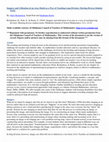
The teaching and learning of long division at the elementary level and beyond has presented a lon... more The teaching and learning of long division at the elementary level and beyond has presented a longstanding challenge for teachers and students alike. As mathematics teacher educators and as a specialized educator, we address the issue by analyzing some of the challenges involved in the teaching and learning of long division – particularly focusing on students who struggle in mathematics. Our inspiration comes from two shared experiences. First, a lesson taught by one of our graduate level, in-service special education teachers inspired us to consider how other teachers could consider teaching division by using an area model. The lesson that began our initial conversations will be shared later in this article to exhibit one teacher’s use of area in teaching division in an interactive manner. Second, these conversations led to our collaborative work on a book chapter that centered on specialized mathematics education (Pratt, Richardson, & Kurtts, in press) In our chapter we focused on...
This study evaluated a multi-year collaborative project between elementary public schools in one ... more This study evaluated a multi-year collaborative project between elementary public schools in one district and university researchers. While the district wanted to improve elementary grades students’ achievement in mathematics, they did not want teachers to adopt an instructional approach where they focused primarily on test-defined content. Using principles from Cognitively Guided Instruction, the partnership focused on promoting teachers’ understanding of mathematical thinking, as it was demonstrated by students, while they completed authentic activities. The authors used cultural-historical activity theory (CHAT) to evaluate how school administrators’ evolving expectations for students’ achievement influenced opportunities for teachers and the university faculty member to demonstrate more dynamic notions of students’ expertise and knowledge.

As a collective, all of the authors agree that at some point in our teaching careers we recognize... more As a collective, all of the authors agree that at some point in our teaching careers we recognized that there were minimal ways to demonstrate division when teaching the algorithm in isolation; furthermore, there are rare opportunities to adhere to the expectations in mathematics education (Common Core Standards Initiative, 2011; NCTM, 2000) that students should be able to identify and use relationships between operations. Imaging is an important activity (Richardson, Pratt & Kurtts, 2010; Wheatley, 1998) that allows for such opportunities. In this article, we outline a series of activities that provide students different representations of division to help them achieve understanding and proficiency of the algorithm due to their understandings of the visual aide. It is important to state here that we believe students should be able to use the division algorithm, but only as it is attached to meaning making and images. We argue that by using Division Quilts, students are better able ...
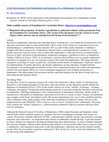
Research in mathematics education and curriculum theory currently has a very limited set of inter... more Research in mathematics education and curriculum theory currently has a very limited set of intersections. Few education researchers claim to work in both fields. I draw on the work of those few researchers for my own understandings as a mathematics teacher educator. Now as a part of this small community, I continue to struggle with what it means to be a mathematics educator from a curriculum theorist‘s perspective. In my journey and in my research, I have come to realize that mathematics is often perceived as an external truth, a fixed set of ideas, and based on that perception, mathematics pedagogy is proffered as basics-as-breakdown (Jardine, Clifford, & Friesen, 2003). As an alternative, I propose that a different way to consider mathematics education is to imagine how one can experience being in the world with mathematics. This being with idea emerged by reviewing two topics in particular: curriculum and the history of mathematics, which are central to my understandings of teac...
Middle level science and mathematics teachers should collaborate to clarify concepts for students... more Middle level science and mathematics teachers should collaborate to clarify concepts for students in each of these disciplines. The topic of proportionality is an excellent choice for a collaborative effort, as understanding proportionality is important in both science and mathematics.
Handbook of Research on Online Pedagogical Models for Mathematics Teacher Education
In this chapter, the author highlights the tools used in an online environment geared toward prac... more In this chapter, the author highlights the tools used in an online environment geared toward practicing teachers earning their master's degree. The focus will be on web-based platforms and the importance of both synchronous and asynchronous online learning. The author offers existing and new online instructors' ideas on how to structure their own synchronous learning environments. She will support her suggestions with relevant research references. Samples of teachers' representations used during class sessions will be included so the reader has a visual understanding of how the tools work. Asynchronous ideas will also be discussed for those who integrate both styles in their teaching.
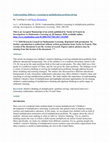
Investigations in Mathematics Learning
This article investigates two children's intuitive thinking in solving multiplication problems fr... more This article investigates two children's intuitive thinking in solving multiplication problems from different educational backgrounds. One of the children is in a southern elementary school in the US. He was given the same problems both in first and second grades. The other child was a first grader in a southwest region of China, and she was given the same problems. The findings reveal a variety of intuitive thinking in solving the multiplication problems through addition beyond direct modeling and counting strategies. The authors also discussed how different educational backgrounds in early elementary mathematics education may affect children's intuitive ideas and reasoning in solving multiplication problems. The study implies the importance of understanding children's intuitive ideas of multiplication and highlights potential opportunities for developing children's understanding of multiplicative thinking and algebraic thinking in earlier stages of arithmetic learning.
Teaching Children Mathematics, 2015
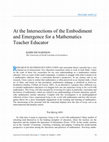
Carolina at Greensboro ESEARCH IN MATHEMATICS EDUCATION and curriculum theory currently has a ver... more Carolina at Greensboro ESEARCH IN MATHEMATICS EDUCATION and curriculum theory currently has a very limited set of intersections. Few education researchers claim to work in both fields. I draw on the work of those few researchers for my own understandings as a mathematics teacher educator. Now as a part of this small community, I continue to struggle with what it means to be a mathematics educator from a curriculum theorist's perspective. In my journey and in my research, I have come to realize that mathematics is often perceived as an external truth, a fixed set of ideas, and based on that perception, mathematics pedagogy is proffered as basics-asbreakdown (Jardine, Clifford, & Friesen, 2003). As an alternative, I propose that a different way to consider mathematics education is to imagine how one can experience being in the world with mathematics. This being with idea emerged by reviewing two topics in particular: curriculum and the history of mathematics, which are central to my understandings of teacher education, specifically mathematics teacher education. Coupled with this investigation is an autobiographical reflection of how I have experienced being in the world with mathematics and how this investigation allows for a more meaningful engagement in the teaching and learning of mathematics. The intertwining of the personal with the contextual displays how the idea of being with is an interconnected and dynamic notion. The Being With So what does it mean to experience being in the world with mathematics? Many models of schooling lend themselves to the banking metaphor of education, where the teachers are the depositors and the students the depositees of information (Freire, 1970). In this model, teachers are on the "outside" of learning-watching, evaluating, and judging. Creating this inside/outside perspective is prevalent among the discourses and practices of mathematics. Watching mathe
Teaching Children Mathematics, 2016
Mathematics teachers can consider ways in which they engage students in algebraic ideas. Based on... more Mathematics teachers can consider ways in which they engage students in algebraic ideas. Based on a study with six elementary school teachers and 115 students in grades 3, 4, and 5, Store et al article discuss ways that teachers might support an understanding of variable as students explore pattern-finding activities. The practices emerged from interviews with teachers and a yearlong observation of teaching algebraic thinking during an after school program at six elementary schools.

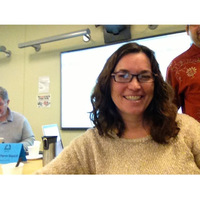


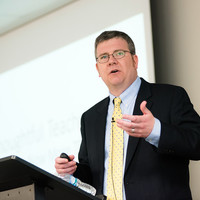




Uploads
Papers by Kerri Richardson